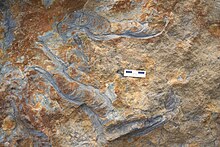Rhizocorallium
This article includes a list of references, related reading, or external links, but its sources remain unclear because it lacks inline citations. (June 2024) |
| Rhizocorallium | |
|---|---|

| |
| Bedding plane view of Rhizocorallium from the Snapper Point Formation (Permian), New South Wales | |
| Trace fossil classification | |
| Ichnogenus: | †Rhizocorallium Zenker, 1836 |
Rhizocorallium is an ichnogenus of burrow, the inclination of which is typically within 10° of the bedding planes of the sediment. These burrows can be very large, over a meter long in sediments that show good preservation, e.g. Jurassic rocks of the Yorkshire Coast (eastern United Kingdom), but the width is usually only up to 2 cm, restricted by the size of the organisms producing it. It is thought that they represent fodinichnia as the animal (probably a polychaete) scoured the sediment for food.
Ichnogenus
[edit]The ichnogenus Rhizocorallium Zenker 1836 includes three ichnospecies: Rhizocorallium jenense Zenker 1836 representing straight, short U-shaped spreite-burrows commonly oblique to bedding plane, and only rarely horizontal, Rhizocorallium irregulare Mayer 1954 representing long, sinuous, bifurcating or planispiral U-shaped spreite-burrows, mainly horizontal, and Rhizocorallium uliarense Firtion 1958 representing trochospiral U-shaped spreite-burrows (definitions after Fürsich 1974).
References
[edit]- Fürsich, F.T. 1974. Ichnogenus Rhizocorallium. Paläontologische Zeitschrift 48, 16–28.
- Kowal-Linka M., Bodzioch A. 2011. Sedimentological implications of an unusual form of the trace fossil Rhizocorallium from the Lower Muschelkalk (Middle Triassic), S. Poland. Facies 57: 695–703.
- Rodríguez-Tovar, F., J., Pérez-Valera F. 2008. Trace fossil Rhizocorallium from the Middle Triassic of the Betic Cordillera, southern Spain: characterization and environmental implications. Palaios, 23, p. 78–86.
- Schlirf, M. 2000. Upper Jurassic trace fossils from the Boulonnais (northern France). Geologica et Palaeontologica, 34: 145–213.
